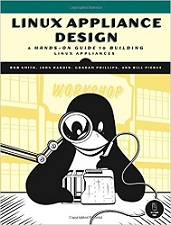
|
FreeComputerBooks.com
Links to Free Computer, Mathematics, Technical Books all over the World
|
|
- Title: Linux Appliance Design: A Hands-On Guide to Building Linux Appliances
- Author(s) Bob Smith, John Hardin, Graham Phillips, and Bill Pierce
- Publisher: No Starch Press (March 31, 2007)
- Paperback: 385 pages
- eBook: PDF (388 pages), ePub, and Mobi (Kindle)
- Language: English
- ISBN-10: 1593271409
- ISBN-13: 978-1593271404
- Share This:

|
Modern appliances are complex machines with processors, operating systems, and application software. While there are books that will tell you how to run Linux on embedded hardware, and books on how to build a Linux application, this is the first book to demonstrate how to merge the two and create a Linux appliance.
You'll see for yourself why Linux is the Embedded Operating System of choice for low-cost development and a fast time to market.
This book shows how to build better appliances - appliances with more types of interfaces, more dynamic interfaces, and better debugged interfaces. You'll learn how to build backend daemons, handle asynchronous events, and connect various user interfaces (including web, framebuffers, infrared control, SNMP, and front panels) to these processes for remote configuration and control.
It also introduces the Run-Time Access library, which provides a uniform mechanism for user interfaces to communicate with daemons.
- Separate your user interfaces from your daemons
- Give user interfaces run time access to configuration, status, and statistics
- Add professional network management capabilities to your application
- Use SNMP and build a MIB
- Build a web-based appliance interface
- Build a command line interface (CLI)
- Build a framebuffer interface with an infrared control as input
- Manage logs and alarms on an appliance
- Bob Smith, John Hardin, Graham Phillips, and Bill Pierce have experience in embedded systems, commercial Linux and BSD appliances, network management systems, and designing software solutions for business problems.
- Embedded and Reatime Systems Programming
- The Liunx Operating Systems
- Unix/Linux Programming
- Miscellaneous and Uncategorized Books

- Linux Appliance Design: A Hands-On Guide to Building Linux Appliances (Bob Smith, et al.)
- The Mirror Site (1) - PDF
-
 Embedded Linux (Karim Yaghmour)
Embedded Linux (Karim Yaghmour)
There's a great deal of excitement surrounding the use of Linux in embedded systems - but not a lot of practical information. This book offers an in-depth, hard-core guide to putting together embedded systems based on Linux.
-
 Embedded Linux System Development: Practical Labs (Bootlin)
Embedded Linux System Development: Practical Labs (Bootlin)
Get your hands on an embedded board based on an ARM processor, and apply what you learned to implement real-time requirements so that you can quickly turn your ideas into a working prototype!
-
 Introduction to Embedded Linux: Lab Instructions (TTO)
Introduction to Embedded Linux: Lab Instructions (TTO)
A real-world hands-on guide to building efficient, high-value, embedded systems with Linux. You'll learn how to build a modern, efficient embedded Linux development environment, and then utilize it as productively as possible.
-
 Building Embedded Linux Systems (Karim Yaghmour)
Building Embedded Linux Systems (Karim Yaghmour)
This book is the hard-core guide to putting together an embedded system based on the Linux kernel, gives you the basics of building embedded Linux systems, along with the configuration, setup, and use open source and free software packages.
-
 O'Reilly® Linux Kernel in a Nutshell (Greg Kroah-Hartman)
O'Reilly® Linux Kernel in a Nutshell (Greg Kroah-Hartman)
Written by a leading developer and maintainer of the Linux kernel,this bookl is a comprehensive overview of kernel configuration and building, a critical task for Linux users and administrators.
-
 The Linux Kernel Module Programming Guide (Peter Salzman)
The Linux Kernel Module Programming Guide (Peter Salzman)
This book is an excellent guide for people who want to write kernel modules. It takes a hands-on approach starting with writing a small "hello, world" program, and quickly moves from there. Far from a boring text on programming,
-
 O'Reilly® Linux Device Drivers, 3rd Edition (Jonathan Corbet)
O'Reilly® Linux Device Drivers, 3rd Edition (Jonathan Corbet)
The 3rd edition of Linux Device Drivers is better than ever. The book covers all the significant changes to Version 2.6 of the Linux kernel, which simplifies many activities, and contains subtle new features.
-
 Linux Kernel Programming: Device Drivers and Synchronization
Linux Kernel Programming: Device Drivers and Synchronization
Discover how to write high-quality character driver code, interface with userspace, work with chip memory, and gain an in-depth understanding of working with hardware interrupts and kernel synchronization.
-
 Linux Kernel Crash Book (Igor Ljubuncic)
Linux Kernel Crash Book (Igor Ljubuncic)
For systems and network administrators and technical support engineers responsible for maintaining Linux systems and networks, this is a first aid guide, it provides quick solutions to a variety of Linux system and network problems.
-
 The Linux Programming Interface: System Programming
The Linux Programming Interface: System Programming
This book is the definitive guide to the Linux and UNIX programming interface - the interface employed by nearly every application that runs on a Linux or UNIX system. It provides detailed descriptions of the system calls and library functions.
-
 Advanced Linux Programming (Mark L. Mitchell, et al)
Advanced Linux Programming (Mark L. Mitchell, et al)
This book focuses mostly on the Application Programming Interface (API) provided by the Linux kernel and the C library. It contains a preliminary introduction to the development tools available.
-
 O'Reilly® Using C on the UNIX System (David A. Curry)
O'Reilly® Using C on the UNIX System (David A. Curry)
This book provides a thorough introduction to the UNIX system call libraries. It is aimed at programmers who already know C, but who want to take full advantage of the UNIX programming environment.





